Tibetan Art
The Thangkas of The Tibetan Medicine
Created between 1687 and 1703, these thangka paintings were commissioned by the fifth Dalai Lama’s regent, Desi Sangye Gyatso, who stepped in as interim ruler of Tibet after the Dalai Lama died in 1682.
The paintings constitute the charts of The Blue Beryl, a text written by Gyatso as commentary of the Four Tantras, the fundamental text of Tibetan medicine.
The main reason that moved Gyatso to create this illustrations was to avoid confusion when interpreting old texts.
Gyatso placed great value on the accuracy of the illustrations depicting such things as the use of omens and dreams for making diagnoses, hundreds of medicinal herbs and medical instruments, and fabulous diagrams of human anatomy.
As stated by the International Academy for Traditional Tibetan Medicine (IATTM) “one of the unique features of Traditional Tibetan Medicine is that it contains a comprehensive philosophy, cosmology, and system of subtle anatomy with associated spiritual practices”.
Today these Thangkas constitute a fundamental piece of educational art that interweave Tibetan Buddhist traditions with centuries-old medical knowledge.
The first painting occupies a privileged place among the others which, in a certain sense, derive from it. It represents the celestial city of the Buddha Bhaisajyaguru, Master of Remedies “Surdasana”. The city is surrounded by four “mountains”. Further more it is square with the palace at its center. The palace, like the whole locality, is an emanation of Buddha Bhaisajyaguru. Its plan evokes a Mandala, with its square enclosure and its four gates oriented in the cardinal directions.
The thangkas not only depict the Buddhist background of Tibetan medicine but also the diagnostic schemes of pulse and urine analysis, picturesque representations of dietary and behavioral advice for treating illnesses, as well as anatomical knowledge,charts for moxabustion, and the elaborate “materia medica” of Tibetan pharmacology.
In fact Twenty-one Thangkas of the original series are devoted to more large human figures illustrating anatomical structures.
The first fifteen compositions have a top register. The registers contain the four main sequential topics relating to the origin myths and state narrative on the Tibetan History of Medicine of the late 17th century.
There are four main sequential topics contained in the registers:
– Medicine Buddha and early Indian Gods and Rishis.
– The Lineage of the Four Medical Tantras.
– The Yutog Nyingtig Lineage.
– The Deities and Protectors of the Yutog Nyingtig.

Follow traditionalartofnepal.com on WordPress.com
Raktayamari Thangka: A Closer Look at the Thangka Worth $45 Million
Overlook
Widely recognised as one of the most important Asian works of art and one of the world’s great textile treasures, this Thangka was recently bought for $45 million.
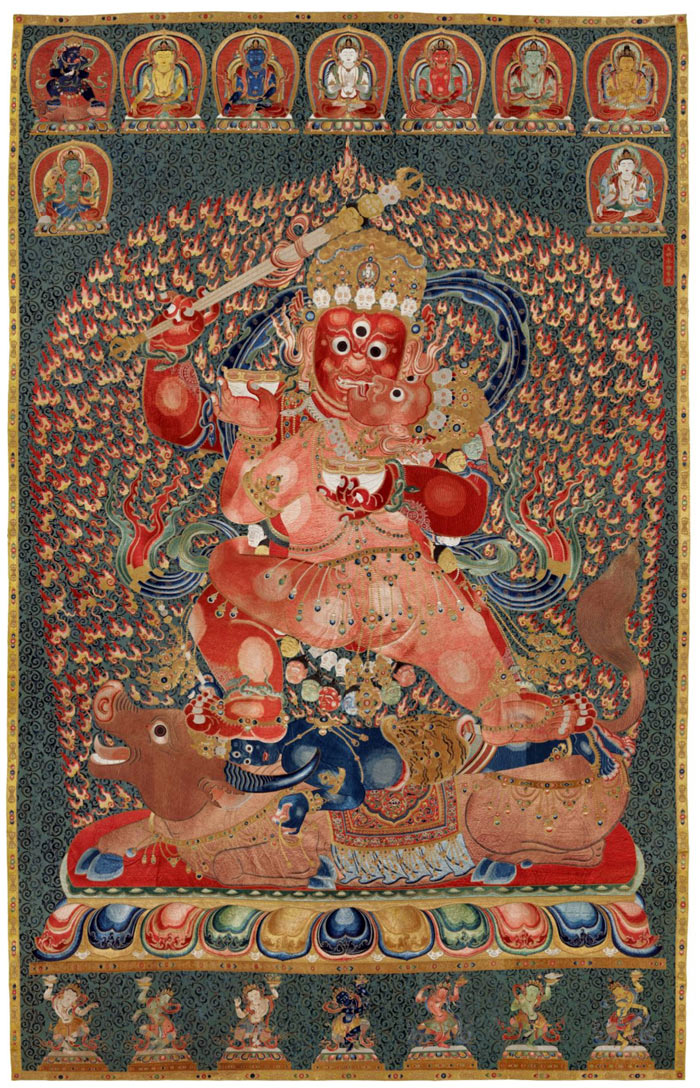
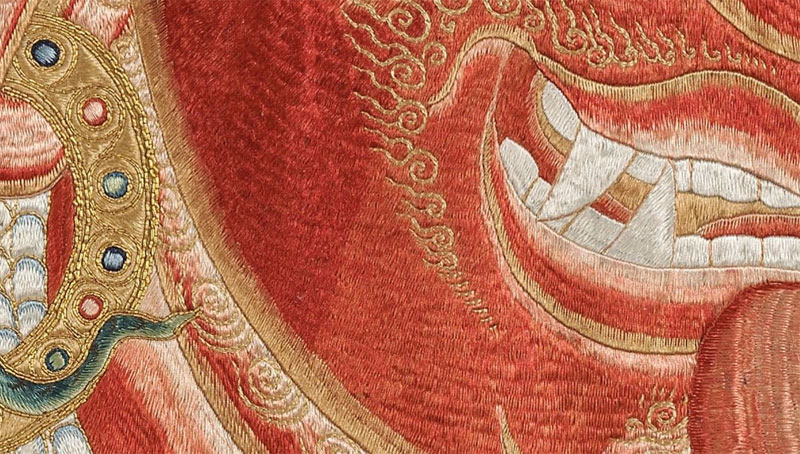
The Thangka depicts the majestic Raktayamari, the red Conqueror of Death, standing in yab-yum embracing his consort, Vajravetali.
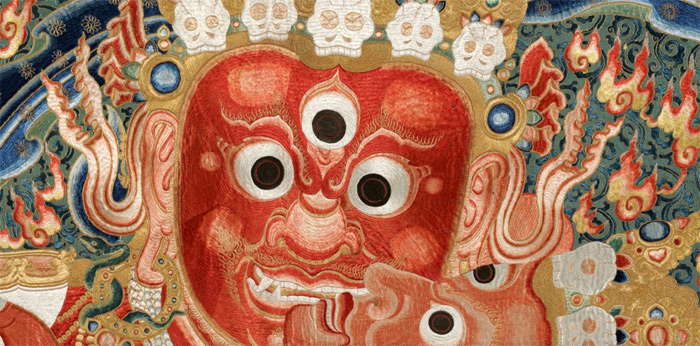
Raktayamari is an important deity of Anuttarayoga-Tantra in Vajrayana Buddhism, and one of the three Yamari forms of Bodhisattva Manjusri (the other two being Vajrabhairava and Krishna-Yamari) revered by various Tibetan sects.
The highlights on the torsos and limbs of Raktayamari and Vajravetali, to denote the musculature, are some of the most common motifs in Nepalese-Tibetan paintings and a notable characteristic of figures in classical Tibetan art.
Highlights and Symbolism
Every aspect of the form of Yamari and the consort Vajra Vetali have symbolic and coded meaning.
The red body color represents the desire to overcome all sufferings and place all beings in the state of enlightenment. The weapon that Raktayamari holds subdues the afflictions (maras).
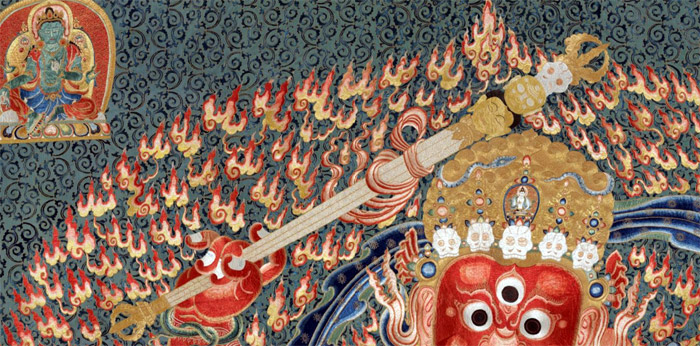
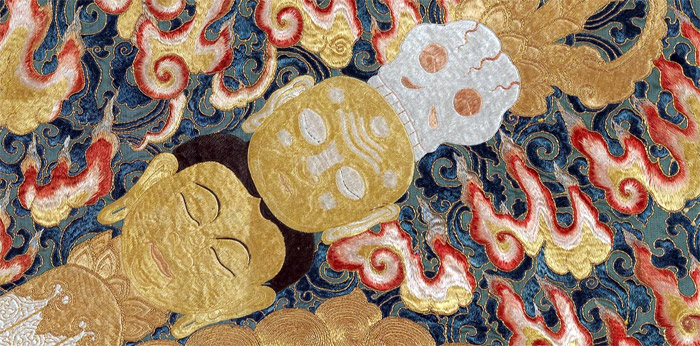
The left hand holds a cup made by ancient Lama’s skull and containing the essence of the four maras transformed.
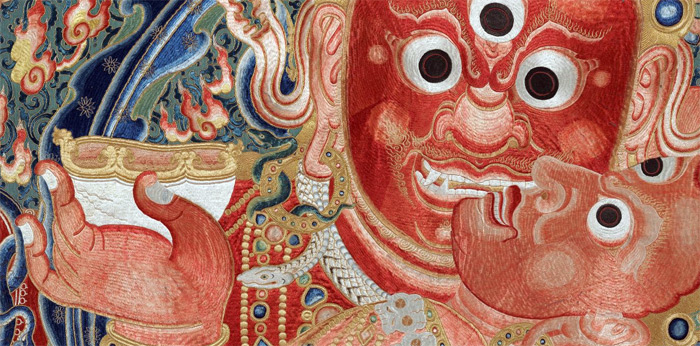
The three round eyes express compassion for all beings in the three times of past, present and future as well as the three watches of the day and three watches of the night.
The orange and red hair is to symbolize the increasing qualities of the Buddha and the aspects of the Mahayana Five Paths.
The crown of five dry skulls symbolizes the five poisons transformed into the five wisdoms.
The necklace of fifty fresh heads represents the vowels and consonants of the Sanskrit language.
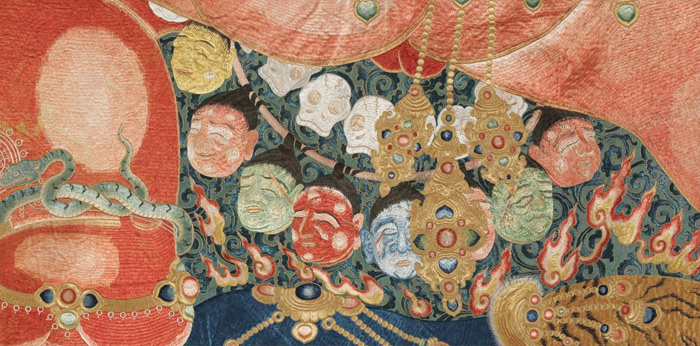
The eight snakes represent the subjugation of various obstacles and the accomplishment of skillful activities.
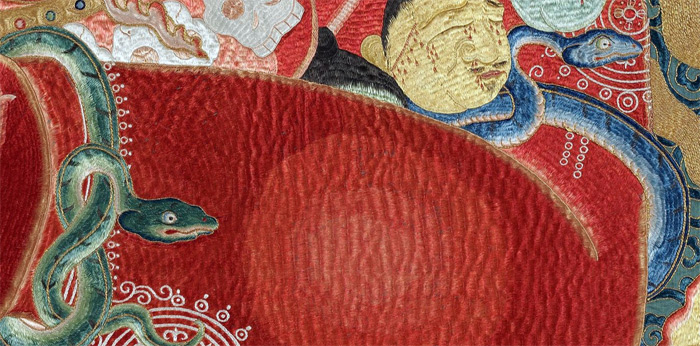
The locked couple is trampling on the blue corpse of Yama, the Lord of death, wearing a tiger skin and crown, lying on the back of their mount, a brown buffalo recumbent on a multi-coloured lotus base.
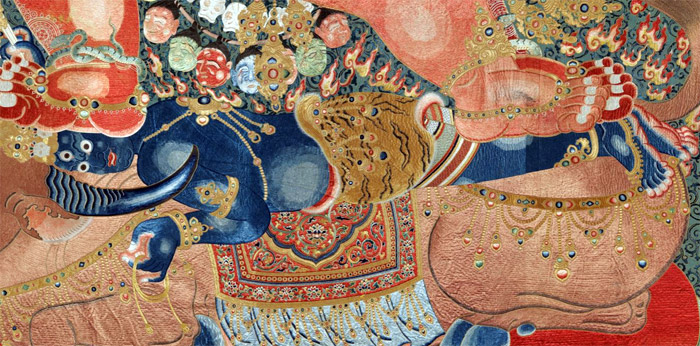
All below two rows of buddhas and bodhisattvas seated on lotus bases, the upper including Heruka Vajrabhairava on the far left and Manjusri on the far right, flanking the five Dhyani Buddhas.

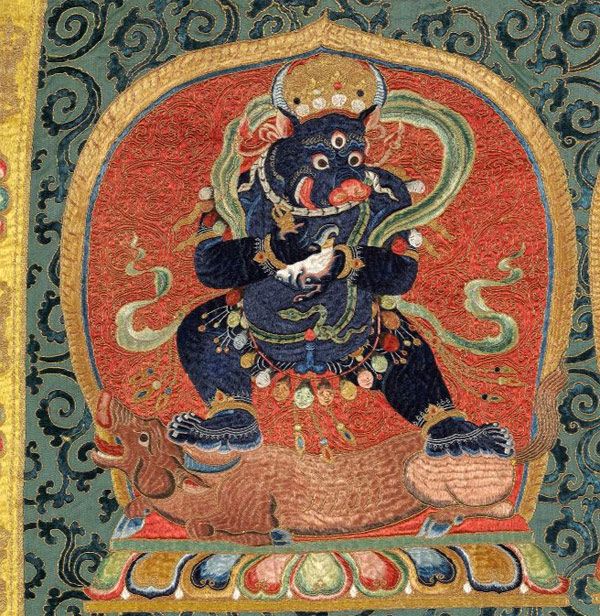
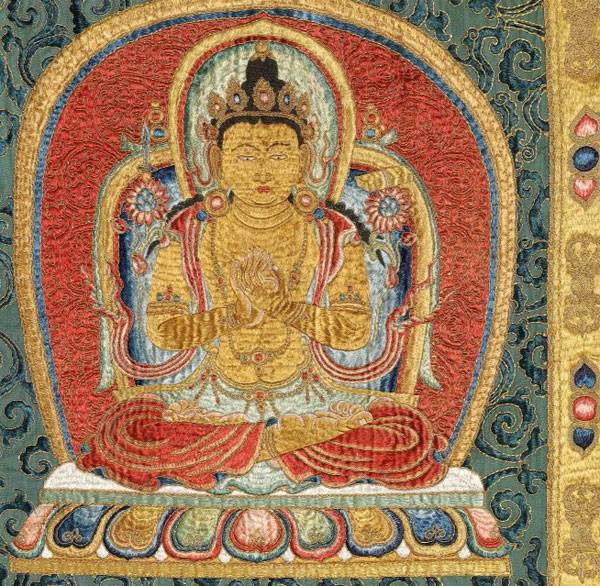
Below this row of deities are two Taras – Green Tara on the left, and White Tara on the right.
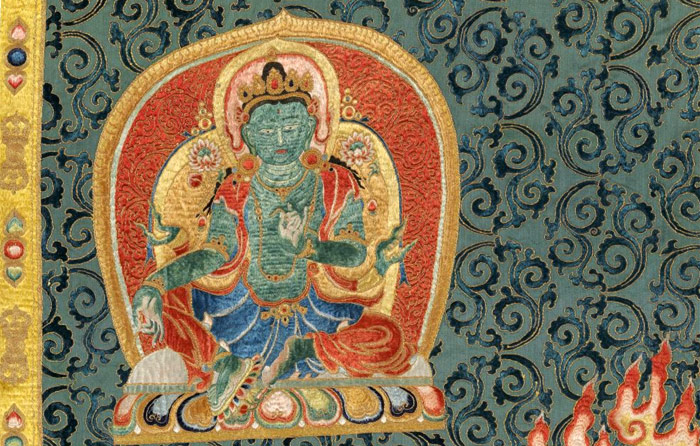
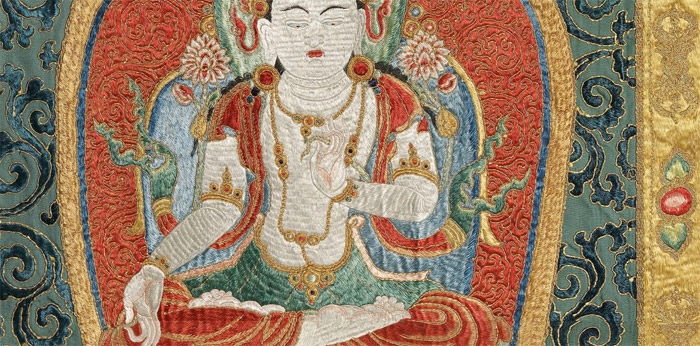
In the lower panel is a row of seven offering goddesses dancing on lotus bases and holding aloft dishes as offerings below the couple.
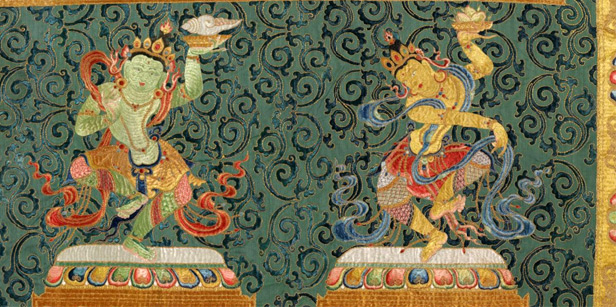
Meaning of the artwork
The metaphor for Rakta Yamari is ‘death.’ The name means the ‘Red Killer of Death.’
In this symbolic meaning the idea of death refers directly to the suffering and unhappiness in the world as described in Buddhist philosophy.
The general appearance of the deity, number of faces, arms, ornaments, decorations and attributes are all part of a mnemonic device (memory system) that incorporates the most essential of Buddhist principles and core teachings into a single object.
The one face represents the embodiment of the wisdom of all Buddhas as having one taste, or flavor, ultimate truth. The red body color represents the desire to overcome all “maras” and place all beings in the state of enlightenment.
Bibilography
Henss, Michael. ‘The Woven Image: Tibeto-Chinese Textile Thangkas of the Yuan and Early Ming Dynatsies’, Orientations, November 1997.
Himalayan Art Resources. Rakta Yamari Main Page. http://www.himalayanart.org/search/set.cfm?setID=349. Jeff Watt, 2-2005.
Himalayan Art Resources. Rakta Yamari Textile. HAR no. 57041. http://www.himalayanart.org/image.cfm/57041.html.
Raktayamari-tantraraja-nama. Gshin rje’i gshed dmar po zhes bya ba’i rgyud kyi rgyal po [TBRC w25383, w25384].
Reynolds, Valrae, ‘Buddhist Silk Textiles: Evidence for Patronage and Ritual Practice in China and Tibet.’ Orientations, April 1997.
George Roerich (trans.), Biography of Dharmasvamin, A Tibetan Monk Pilgrim. Patna: K.P. Jayaswal Research Institute, 1959.
George Roerich (trans.), The Blue Annals. Delhi: Motilal Banarsidas, 1996, 2nd ed.

Follow traditionalartofnepal.com on WordPress.com
The Himalayan Times: Sacred Nepali art losing colors
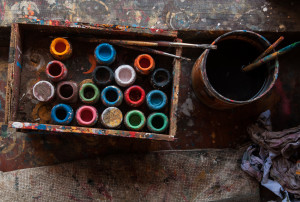 Extract from thehimalayantimes.com
Extract from thehimalayantimes.com
One of the traditions Nepal can really pride itself upon is the art of thangka paintings — which are so exquisite that foreigners have been known to extend their stay to learn the techniques. However, the rise of unhealthy competition, lack of regular-isation and emigration of artists is posing a threat to the inventive profession. Thangka is a Tibetan silk painting with embroidery, usually depicting a Buddhist deity, famous scene, or mandala. It is done on cotton canvas — found in Asian countries such as Tibet, Nepal, Bhutan, India and Mongolia — used exclusively for this purpose. Native Buddhists of Kathmandu valley call it ‘pauva chitra’ whereas it is also known as ‘tangka’, ‘thanka’, or ‘tanka’.
These paintings lucidly represent Buddhist deities and divinities that appear in sacred Buddhist practices called ‘sadhana’. This means artists are not allowed to use their imagination. There is also a belief that thangka emanates positive vibrations and good luck. “Thangkas may merely seem like beautiful and luxurious showpieces for those who are unaware about Buddhist beliefs. But for Buddhists, it is a sacred tool for meditation and purification of the soul,” says Anil Ghising, general secretary of Thangka Traders Association (TTA).
The most popular thangka designs include mandala, wheels of life and life of Buddha. They can be divided into three categories according to the quality — student piece, medium piece, and master-piece. Student piece is the work of a practitioner with a year’s experience, medium piece is the work of an artist who has over five years of experience, whereas master-pieces are created by artists with over 15 years of experience in thangka painting.
This is the major reason for the difference in the prices of similar-sized thangkas. The lack of uniformity in prices also depends upon size, art, toil and materials used. The price of thangkas begins at around Rs 500 and goes up to millions of rupees.
Meanwhile, Hajar Singh Lama, president of TTA, laments about the unhealthy competition in the market. He says, “The trend of pre-set contract with tourist guides is the major reason for such competition. Tourists are compelled to buy thangkas at the store specified by the guide, which is akin to deception.” According to him, the best way to stabilise the business is to draft and implement regulations for establishing thangka shops. Thamel, Bhaktapur and Boudha are the core areas for buying thangkas, whereas one can get them at Patan, Swoyambhu and Changu Narayan as well. According to TTA data, 222 thangka galleries function from Kathmandu valley, of which 72 are in Thamel.
Anil informs that the process of making thangka is very tedious. “An artist needs to meditate before starting his piece. Patience and dedication are essential to complete the assignment, which I feel is lacking in the new generation,” he says. Worried about the future of the industry, he suggests the government to include thangka and Buddhist scroll paintings in academia. He adds, “Thangka artists are gradually migrating to foreign lands, which threatens survival of the entire business. The government should carry out concrete work if it wants traditional art to be preserved for future generations.”
Another complaint of thangka artists is the lack of increment in business during ongoing Nepal Tourism Year. “The number of tourists has increased, but since majority of tourists come on special packages, our business has not fostered as we’d hoped,” laments Akka Lama, owner of Tibetan Thanka and School of Thanka Painting at Thamel. According to him, global economic crisis, political instability, and insecurity are main causes for the annual decline in business. However, Lama optimistically says, “The country can benefit from the tourism industry, if the government and concerned professionals concentrate on reducing the challenges and work towards making Nepal a tourist-friendly destination with ample facilities and attractions — one of them being thangka.”
Agreeing with this, Narayan Shrestha, owner of Traditional Art and Handicraft at Patan, says, “Our business relies upon foreigners, so the government should plan well to attract budget tourists.”
He opines that various ministries need to join hands to uplift thangka, tourism, and the nation as a whole.
SUJATA AWALE

Follow traditionalartofnepal.com on WordPress.com
Brief Introduction To Thangka and Mandala Paintings
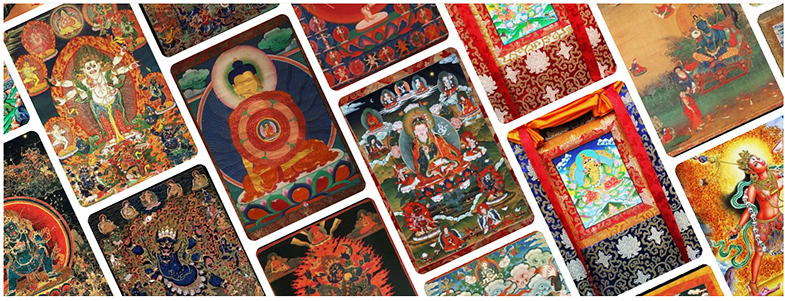
Thangka (also known as Pauva or Pauba पौभा in Nepali) is a painting usually illustrating a Buddist mandala or a deity. Unlike other painting, a thangka consists of picture painted or embroiled over a cotton cloth and then mounted on a silk frame cover. Although they are delicate in nature, these artworks last a very long time time and retain much of their lustre.
Thangkas served as important teaching and meditating tools. Most of the first artworks depicted the life of the Buddha, various influential lamas and the most relevant deities and bodhisattvas.
The most common subject depicted in the entry of Buddhist monasteries is “The Wheel of Life”, which is a diagram depiction of the Abhidharma teachings and the main concepts of Buddhist doctrine.
The paintings of Buddha Life were painted by lamas and monks in monasteries both in Tibet and Nepal. This knowledge was transmitted to members of the monks families and then spread among lay people and devotees that started thangka art painting schools, especially in the Kathmandu valley.
A thangka painting can be considered as an object of decoration, but its spiritual importance is more relevant, especially for Buddhist monks and scholars who revere it with mystic power accordingly to the deities represented.
Devotional images act as the centerpiece during a ritual or ceremony and are often used as mediums through which one can offer prayers or make requests. Overall, and perhaps most importantly, religious art is used as a meditation tool to help bring one further down the path to enlightenment.
Images of deities can be used as teaching tools when depicting the life (or lives) of the Buddha, describing historical events concerning important Lamas, or retelling myths associated with other deities.
History of Thangka in Nepal
Thangka is a Nepalese art form exported to Tibet after Princess Bhrikuti of Nepal, daughter of King Lichchavi, married Songtsän Gampo, the ruler of Tibet and thus imported the images of Nepalese deities to Tibet. History of thangka Paintings in Nepal began in 11th century A.D. when Buddhists and Hindus began to make illustration of the deities and natural scenes.
Historically, Tibetan and Chinese influence in Nepalese paintings is quite evident in Thangkas.
It was through Nepal that Mahayana Buddhism was introduced into Tibet during reign of Angshuvarma in the seventh century A.D. There was therefore a great demand for religious icons and Buddhist manuscripts for newly built monasteries throughout Tibet.
A number of Buddhist manuscripts were copied in Kathmandu Valley for these monasteries.
The influence of Nepalese art extended till Tibet and even beyond in China in regular order during the thirteenth century. Nepalese artisans were dispatched to the courts of Chinese emperors at their request to perform their workmanship and impart expert knowledge. The exemplary contribution made by the artisans of Nepal, specially by the Nepalese innovator and architect Araniko, bear testimony to this fact even today.
From the fifteenth century onwards, brighter colours gradually began to appear in Nepalese Thangka. Because of the growing importance of the Tantric cult, various aspects of Shiva and Shakti were painted in conventional poses. Mahakala, Manjushri, White Tara, Chenrezig and other deities were equally popular and so were also frequently represented in Thanka / Thangka paintings of later dates.
As Tantrism embodies the ideas of esoteric power, magic forces, and a great variety of symbols, strong emphasis is laid on the female element and sexuality in the representation of Dakinis and female Goddesses.
Realizing the great demand for religious icons in Tibet, Nepalese artists, along with monks and traders, took with them from Nepal not only metal sculptures but also a number of Buddhist manuscripts. To better fulfill the ever – increasing demand Nepalese artists initiated a new type of religious painting on cloth that could be easily rolled up and carried along with them.
This type of painting became very popular both in Nepal and Tibet and so a new schools of thangka painting evolved as early as the ninth or tenth century and has remained popular to this day.
One of the earliest specimens of Nepalese thangkas dates from the thirteenth century and shows Buddha Amitabha surrounded by Bodhisattva. The Mandala of Vishnu dated 1420 A.D., is another fine example of the painting of this period.
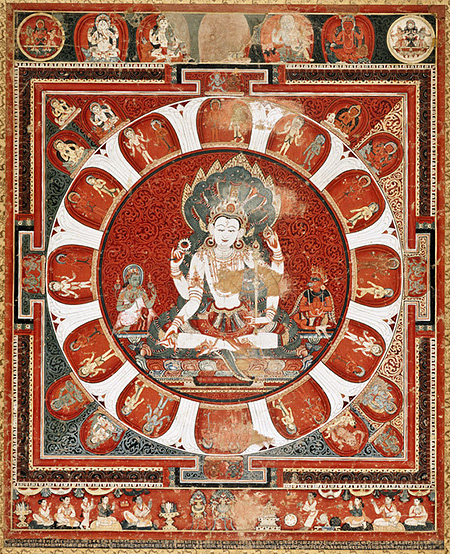
Early Nepalese Thangkas are simple in design and composition. The main deity, a large figure, occupies the central position while surrounded by smaller figures of lesser divinities.
During the reign of Tibetan Dharma King Trisong Duetsen the Tibetan masters refined their already well developed arts through research and studies of different country’s tradition.
Thanka painting’s lining and measurement, costumes, implementations and ornaments are mostly based on Indian styles. The drawing of figures are based on Nepalese style and the background landscapes are based on Chinese style.
Thus, Thangka paintings became a unique and distinctive art.
Thangkas are produced mostly in the northern Himalayan regions among the Newari, Lamas, Gurung and Tamang communities.
Entire families belonging to these communities have preserved this art for generations, which provide today substantial employment opportunities for many people.
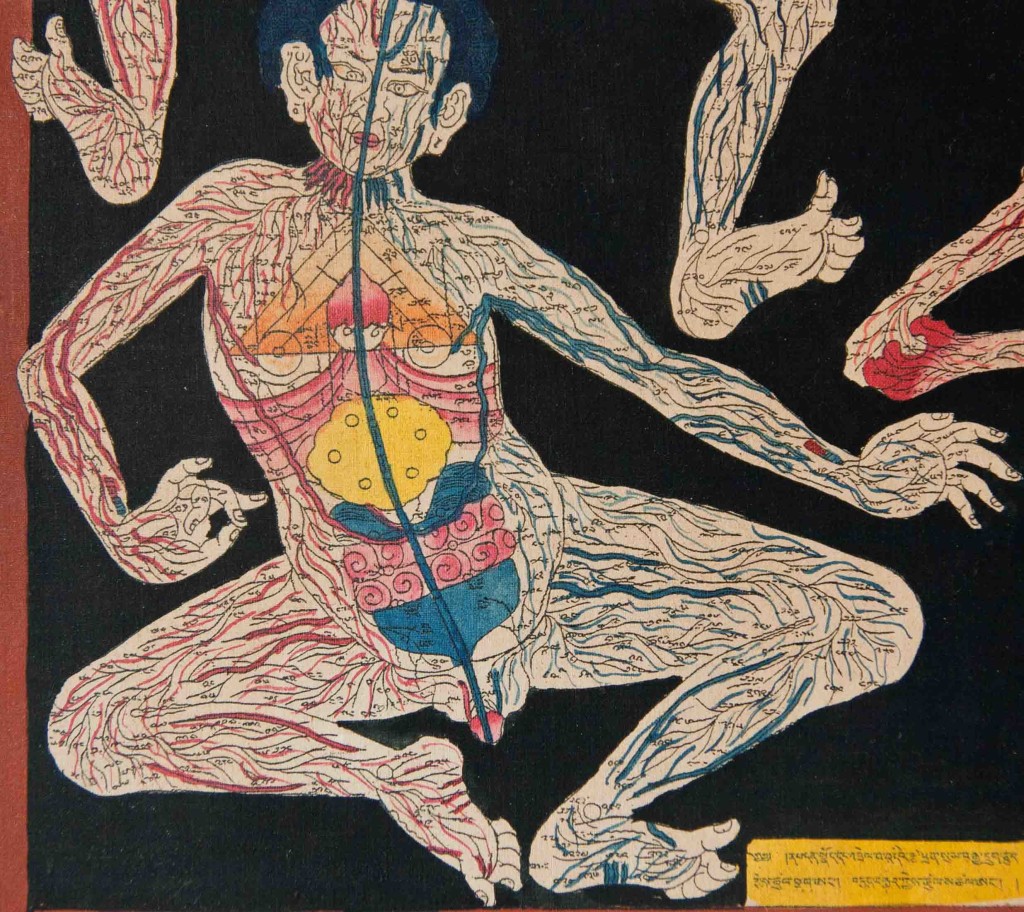
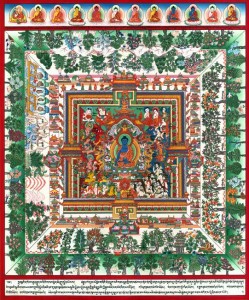
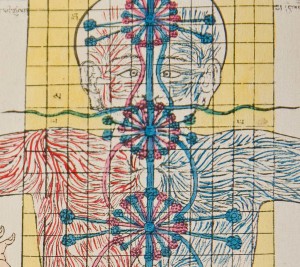
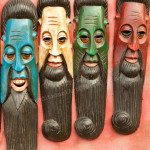 Sadhu Baba Masks
Sadhu Baba Masks 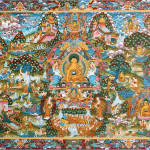 Life of Buddha Master Thangka
Life of Buddha Master Thangka 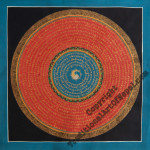 Triple Yin-Yang Mandala
Triple Yin-Yang Mandala 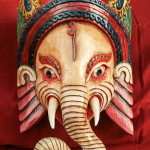 Ganesh Mask Design #01
Ganesh Mask Design #01 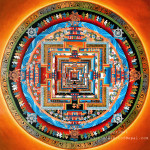 Kalachakra Mandala
Kalachakra Mandala 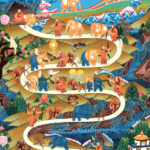 Samatha Meditation Thangka
Samatha Meditation Thangka 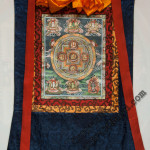 Silk Frame #02
Silk Frame #02 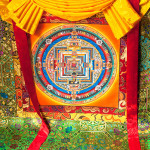 Modern Design Brocades
Modern Design Brocades 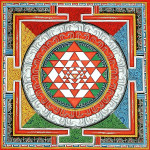 Sri Yantra Mandala
Sri Yantra Mandala 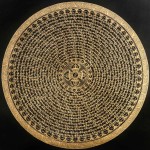 Yin Yang Mantra Mandala
Yin Yang Mantra Mandala 





